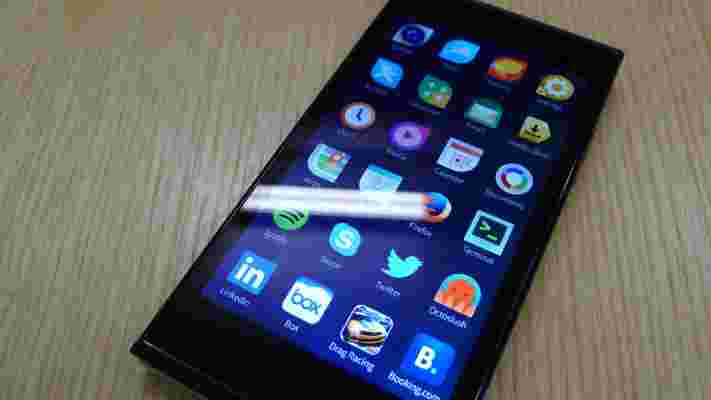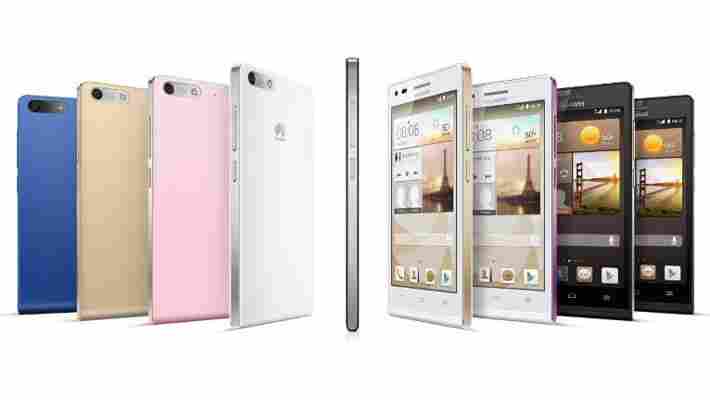Jolla was founded by a group of ex-Nokia employees who strongly believed that MeeGo deserved a second chance. Two years on, the Finish startup is launching its first smartphone with a new take on the forgotten platform, called Sailfish OS .

I went hands-on with an early version of the Jolla smartphone in June and came away feeling curious, but unconvinced by the execution. Today, I was able to examine a final build of the device and see if my earlier reservations were unfounded. Can a reinvigorated MeeGo compete with Windows Phone, Firefox OS and Tizen for third place in the smartphone market?
The Jolla smartphone is dense, compact and regimented. From afar, the two-part design gives the device a thick, slightly bulbous look, but it’s actually less than 10mm thick and in the hand, it feels surprisingly slim.
The 4.5-inch display is the focal point of the handet. Aside from the power button and volume rocker, the device is devoid of any hardware buttons. This gives the front of the Jolla smartphone a clean, minimalist look whenever you lay it down on a flat surface.
As soon as you turn the device over, the scrappy startup’s design aspirations are apparent. Every Jolla smartphone comes in a reserved matte black on the front, but the back cover is available in a range of colors including red, teal and navy blue. These two halves were designed specifically to contrast with one another: The front panel is flat along the top but rounded on the sides, while the back is precisely the opposite. They clash in a way that we haven’t seen in a smartphone before: It’s an unfamiliar look, but one that slowly grew on me.
Two small speaker grilles lie on the bottom of the handset, alongside a standard headphone jack and microUSB port up top. Jolla has etched its rather beautiful logo on the top of the device and on the standard rear back covers, but otherwise there is very little branding or blemishes on the device.
Jolla has opted for a brave, memorable design here, but it’s not the most attractive or premium smartphone on the market. The first Sailfish OS smartphone is certainly distinct and different, but that doesn’t mean it’s any better than what’s already out there.
Jolla is pushing the idea of a smartphone formed from two different halves. Each removable back cover is light and flimsy, but through an NFC chip it can be used to activate specific content normally dormant on the device or the Jolla Store. The company’s own offerings tweak the look of the UI to match the color of the cover, creating a harmonious design between software and hardware.
The hope is that third-party brands will create their own covers, which consumers can then buy to unlock new content from within the Jolla store, including apps, wallpapers, fonts and sounds. Barcelona Football Club, for example, could offer a background image of the team and a well-known chant or anthem as the ringtone.
The startup also hinted that these covers could be used to add new hardware features. Throughout my fairly brief testing period, I was able to use a few of Jolla’s self-produced covers, but the scope and ambition of the concept is evident. These covers are yet to be used in a truly meaningful way, but that could change once third-parties start experimenting with the device.
For the most part, the design of Sailfish OS remains unchanged since I last saw the Jolla smartphone. The power button or a concise double-tap on the screen wakes the device, revealing a lock screen with the time, your recent notifications, connectivity and sound profile.
None of these icons are actionable though. It’s a static visualization, so to find any of your emails, text messages or Facebook alerts, you’ll need to dig a little deeper into the UI of the Jolla smartphone. Pulling down from the top of the screen reveals a pulley menu with quick actions based on where you are within Sailfish OS. For the lock screen, this includes quick access to the camera, the contacts in your address book and system settings.
Sailfish OS is constructed using a vertical UI though, rather than the horizontal design that most of us have grown accustomed to on Android and iOS. It’s no less intuitive than these platforms, but it’s certainly different. After waking the device, a swipe up reveals the home screen with an app dock and app switcher.
It’s a three-by-three grid that offers a small preview of the nine most recently used apps. An immediate concern is that as soon as you boot a tenth app, the ninth will immediately disappear from the switcher. Most days, I’m rarely using more than nine apps simultaneously, but the cap is certainly notable. There is a workaround though: When you long-press to close a piece of software, the device will show all of the apps that are currently running on the device.
Tapping on the thumbnail once will launch the app, but with a long-press you can also slide to the left or right to access one of two shortcuts. The address book app, for instance, lets you jump to either the dialer or your list of contacts.
Swiping up from the home screen reveals the app drawer. Immediately, you’re hit by the quality of the app icons. They’re bright and beautiful, with an unusual cuboid shape that Jolla has rounded off at two opposing corners. Hands down, I think these designs are better than the stock offerings on iOS and Android.
Unfortunately, the handset that I used was plagued with technical issues. The Jolla team warned us of a few known bugs going in, but there were a number of unforeseen problems. Apps would crash, stutter or launch randomly, and many of the gestures didn’t behave as expected. Even if a small percentage of these problems make their way into the retail version, I suspect Jolla’s customer support team is going to have their work cut out.
Unlike iOS and Android, you can swipe up from the bottom of the display to access the Sailfish OS notification center, known as Events. Tapping on the alert will send you to the app in question, while a long-press will dismiss it from your list. Deleting notifications in this fashion is a little slow, especially in comparison to the fantastic swipe-to-dismiss gestures found in Android.
Android smartphones have a reputation for sub-par cameras, so Jolla had the opportunity to differentiate with its first smartphone.
The handset is equipped with an 8-megapixel rear-facing camera, but sadly it produces some pretty underwhelming images. Files are recorded with an unacceptable amount of noise, even in optimal lighting conditions.
The camera app is fairly intuitive, with limited white balance, focusing and flash options from a pull-down at the top of the screen. Experimenting with these tools can offer some small improvements, but it’s not enough to rectify the underlying problems.
Jolla offers some basic Sailfish OS apps covering email, maps, notes, calendar appointments and more. The Jolla Store is almost empty though, with few high-profile names aside from Wikipedia.
The saviour is Android. Once you’ve downloaded the relevant app from Jolla’s marketplace, the Yandex Store will be added to the device and you can download a number of apps that support Android 4.2. These reside in the app drawer and are integrated with the home screen app switcher, just like any other piece of Sailfish OS software.
Android and Sailfish OS have a different design language, so using apps conceived for Google’s mobile operating system can be pretty jarring sometimes. Nevertheless, it’s a welcome solution for the app support problem.
BlackBerry and Windows Phone have struggled to boost their native app offerings, however if Jolla can keep up with Google’s firmware updates, it might be able to avoid that problem entirely. Unlike BlackBerry 10, Android feels like an embedded part of the Sailfish OS experience. Access to the Google Play store would have been ideal, but the Yandex Store is a serviceable alternative.
The Jolla smartphone is certainly unique. The styling of the hardware is unusual and the gesture-based Sailfish OS is intriguing. I enjoyed my time with the device, but I’m still not sure who this handset is for.
If you’re not happy with iOS, Android or Windows Phone, the Jolla smartphone is worth looking at. But how many people feel that way? Power users and tech aficionados perhaps, but my gut feeling is that most consumers will be satisfied with one of those three platforms.
It’s too early to make a final judgement on the Jolla smartphone, but it surprised me in ways that I didn’t expect. A flawed, but unashamedly atypical device.
Ex-Valve employees bring augmented and virtual reality glasses castAR to Kickstarter
CastAR is a pair of augmented reality and virtual reality glasses that can create and vizualize 3D holographic images in front of you. Created by ex-Valve employees Jeri Ellsworth and Rick Johnson – now operating under the name Technical Illusions – the pair are hoping to fund their innovative hardware project through crowdfunding site Kickstarter .

The glasses are capable of recreating experiences similar to the iconic holographic ‘ Holochess ‘ chessboard from Star Wars: Episode IV – A New Hope. Unlike virtual reality headsets such as the Oculus Rift , castAR doesn’t require an expensive wide-angle display; instead, the device combines two micro-projectors, a pair of active shutter glasses, a tracking camera and a special mat embedded with infrared LEDs. An optional clip-on attachment can then transform them into some full-on virtual reality eyewear.
At the time of writing, the funding page has $52,906 raised, with 31 days remaining to reach its final target of $400,000.
The Kickstarter page explains that castAR uses two peripherals, called the Magic Wand and RFID Tracking Grid, to make the effect authentic and immersive. The former (which looks like a wand from Harry Potter, albeit with an analog stick and some basic buttons) lets you position items within a 3D space, while the latter can be used to track and identify physical objects on a flat surface.
One use-case is the popular table-top role playing game Dungeons and Dragons. Using simple play pieces or ‘stamps’, the Dungeon Master can quickly create a new map and then play with other enthusiasts – either locally or online. The potential implementations are vast though; 3D design and data vizualization are two immediate use-cases that spring to mind.
The hardware itself looks primitive for now and has been developed with PC users in mind, however this is a first draft prototype, so I wouldn’t be surprised if the design changed in the future.
You can snag a castAR unit from $189 and the first units are expected to ship in September 2014.
Huawei unveils the Ascend G6, a skinny 4G-enabled Android smartphone
Huawei today unveiled the Ascend G6, a new mid-range Android handset with optional 4G connectivity. The handset follows the industrial design of the Ascend P6 , which Huawei claimed to be the world’s slimmest Android smartphone when it launched in June last year. It weighs 115 grams and is only 7.85mm thin, which is slightly thicker than the P6 (6.18mm) but still delightfully slim in its own right.

The Ascend G6 has a 4.5-inch display set at a 960×540 resolution (245 pixels-per-inch) and is powered by a quad-core 1.2 GHz processor and a 2000 mAh battery. It packs an 8-megapixel rear-facing camera and is 4G LTE-enabled, supporting up to 150 Mbps, although a 3G-only version will also be available.
The 4G version of the Ascend G6 will be available in black with grey and rose gold highlights, or white with pink or champagne gold highlights, from April this year. The 3G-only model will arrive in black, white, pink, gold or blue during the first quarter of 2014.
Huawei teased the Ascend P7 in an unusual video last week, which poked fun at both Apple and Samsung ahead of its press conference at Mobile World Congress. The short clip, which used an iPhone and Apple’s Siri search assistant to hint at its latest hardware, also referenced two new tablets – we expect Huawei will give us the full details on these soon enough.
Gallery:
Visit our MWC 2014 page for more coverage
Image Credit: Aaron tam/AFP/Getty Images
